Introduction to DeWalt Nailers
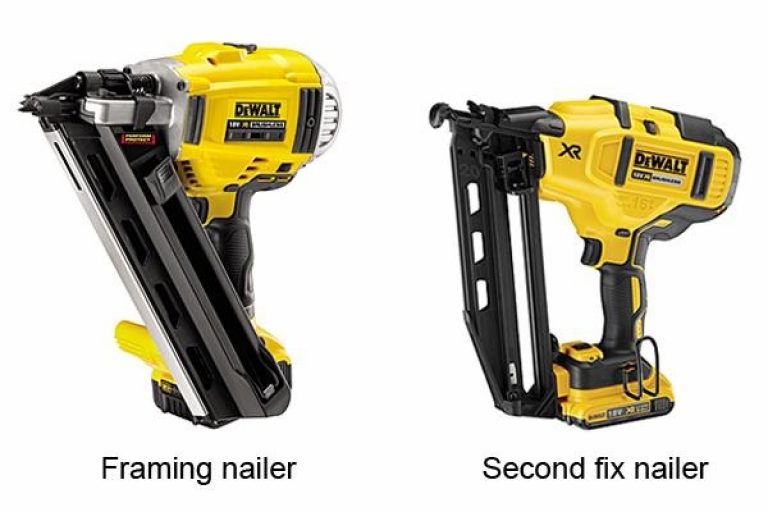
Also known as a nail gun, a nailer is a powerful tool that lets you insert thousands of nails in a single day. Not only will it save you time and energy, but you’ll be able to achieve far more accurate and consistent results than would be possible with a hammer.
Used properly, a nailer can shoot fasteners below the surface of the wood without making any dents to leave a smooth, high quality finish. Nail guns are used by many tradespeople including construction workers, carpenters, joiners and roofers. They are also popular with self-builders and DIY home owners.
Framing nailers are best for large heavy-duty projects such as deck construction, timber framing and fence construction. Finish (second fix) nailers are slightly smaller and lighter, making them suitable for tasks requiring more accuracy including assembling furniture, fixing window and door frames, and installing decorative trim such as skirting boards and coving.
What are the different types of Nail Gun?
Nailers may be pneumatic (powered by air using a compressor), fuel-driven (powered by gas cartridges) or electric (either corded or cordless).
Pneumatic nail guns are very effective on hard materials but have to be attached by a hose to a mains-operated air compressor. This can prove cumbersome – and you always need to be close to a power source.
Gas-powered nailers are fully portable as they run off small disposable cartridges which fit inside the housing. However, they give off unpleasant fumes and perform poorly in low temperatures. The expense of replacing the canisters can also make these tools a costly long-term option.
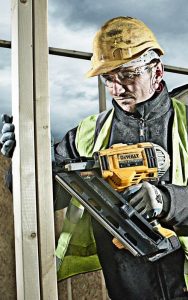
Corded electric nail guns do away with the need for compressors and cartridges, but require a nearby power source – which isn’t always guaranteed on a building site – and of course you’ve got to keep the cable out of the way while you work.
Cordless nailers use rechargeable Lithium-Ion batteries, which provide a lightweight yet powerful solution to the problems posed by gas canisters, hoses and electric cables. They are becoming increasingly popular among both tradespeople and DIY users.
Benefits of a Cordless Nail Gun
The main advantage of cordless nailers is their portability. No longer do you have to nurse a gas cartridge in your pocket to warm it up before it will work in cold weather, or search around for an electric socket on a building site. Cordless nail guns are fume-free, can be used anywhere and are not affected by changes in temperature, so make a good all-round choice.
No preparation is needed. You can simply load the collated nails into the magazine, insert the battery pack and start work straight away. A cordless nailer will operate in conditions ranging from -20° to 50°, and requires minimal maintenance – unlike gas-powered models, which need frequent cleaning.
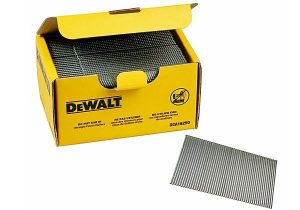
Other points to think about include:
Size and type of nails you intend to use – make sure they will fit in the nailer and that it is powerful enough to fire them properly.
Size, weight and balance of the nail gun. Some are more top-heavy than others, making them unwieldy.
The desired finish – if the surface of the workpiece is likely to be visible afterwards, choose a nailer with a rubber tip that won’t leave marks.
There are many different nailers on the market including roofing, flooring, brad, stapling and palm nail guns, all designed to tackle various specialist tasks. However, we will be focusing on two of the most popular and versatile types: framing nailers and second fix, or finish, nailers.
What's the difference between a Framing Nailer and a second Fix Nailer?
Framing Nailer
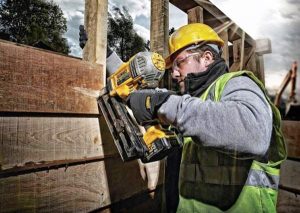
A framing nailer, sometimes referred to as a first fix nailer, is a heavy-duty tool used mainly for high volume construction projects where you need to insert a lot of long nails in a short space of time.
It is particularly well suited to large-scale tasks such as fastening house framing, wood cladding, fences, floorboards and joists, constructing decks and building extensions.
Second Fix Nailer
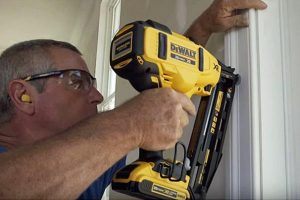
Also known as a finish or finishing nailer, this type is smaller, lighter and more precise than a framing nailer and makes a great all-round nail gun.
It is a versatile tool which can be used for a wide variety of applications. These include making furniture and cabinets, securing window and door frames, and fitting architraves, coving, skirting boards, dado rails and decorative mouldings.
What's the difference between a Framing Nailer and a second Fix Nailer?
Some of the key features you should take into account include:
Dual speed
Brushless motor
Bump (rapid fire) and sequential (precision) modes
Depth control
Easy jam clearing
High-capacity batteries
Lock-off button
Ergonomic design
Dry fire lock-out
Versatile magazine angle
Non-mar contact tip
Dual Speed
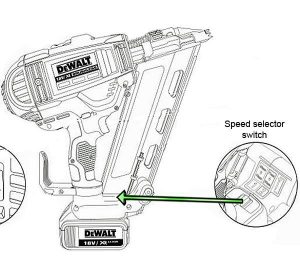
Having a choice of two speeds – or power levels – is a relatively new but extremely valuable feature, making this type of nailer highly versatile and saving battery life. It extends the range of the tool, allowing you to use it on a wide variety of nails, from 50mm right up to 90mm diameter.
Being able to use the lower speed for firing small nails lets the nail gun work more efficiently as it won’t be using excessive power to get the job done.
When you come to tackle longer nails or tougher materials, you can turn to the faster, more powerful setting for some extra oomph.
Brushless Motor
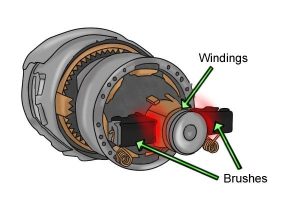
A brushless motor offers great run-time and performance, but what is it? Both brushed and brushless motors operate using an electro-magnetic field with a current flowing through it.
A brushed motor (pictured) uses carbon brushes to deliver current to the motor windings (copper coil) situated directly on the rotating shaft. This creates friction, which causes the brushes to eventually wear out.
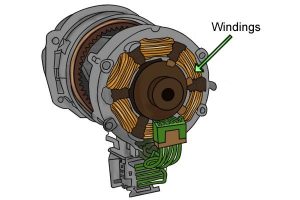
In a brushless motor (pictured) the windings are wrapped around the outer, stationary part of the motor. Magnetic sensors are used instead of direct contact with the rotating shaft, so no brushes are needed.
Friction, heat and noise are greatly reduced, resulting in a cooler, quieter and more efficient motor. The tool can be made lighter and more compact, as no brush housing is required.
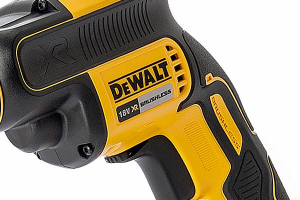
A tool with a brushless motor may be more expensive than one with brushes, but is much more effective because the motor will adjust its power according to the task at hand, saving battery life.
And as there are no brushes to wear out, the motor will last much longer, with maintenance kept to a minimum.
Bump Operating Mode
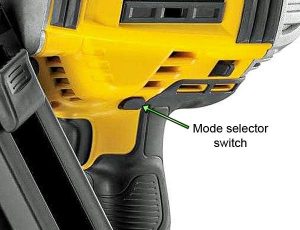
The bump, or rapid fire mode is ideal for fast, high-volume production work on flat surfaces.
On this setting, as long as you keep the trigger depressed the nail will be fired each time you bump the tip of the nail gun against the workpiece.
It’s a speedy way of working and is especially effective on large items such as fence panels, shed walls and garden trellis.
Sequential Operating Mode
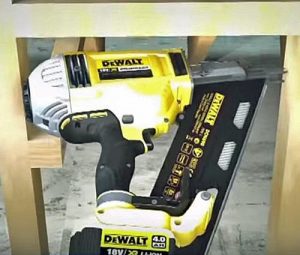
The bump, or rapid fire mode is ideal for fast, high-volume production work on flat surfaces.
On this setting, as long as you keep the trigger depressed the nail will be fired each time you bump the tip of the nail gun against the workpiece.
It’s a speedy way of working and is especially effective on large items such as fence panels, shed walls and garden trellis.
Depth Control
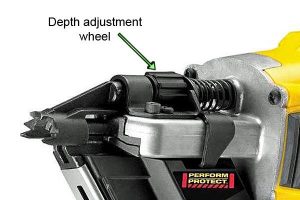
The tool-free depth adjustment thumb wheel makes it easy to drive every nail to exactly the same level, enabling you to achieve a strong, consistent and professional-looking finish.
Viewed from behind the tool, you simply turn the depth adjustment wheel to the right for a deeper setting, and to the left for a shallower setting.
Easy Jame Clearing
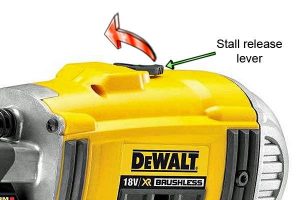
You can flip a lever on top of the nailer to reset the tool if it stalls, and jammed nails can be easily removed with the help of a hex key housed at the bottom of the handle.
Indicator lights on the back of the nail gun will flash to alert you if there is a stall or blockage, or if the battery is running low.
High-Capacity Batteries
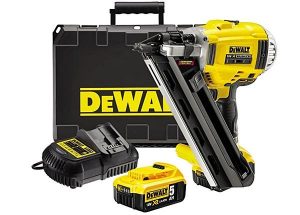
The powerful 5.0Ah battery packs provide excellent run-time, allowing you to drive at least 750 nails from a single charge.
Each pack takes only 90 minutes to recharge, so you won’t be waiting long. The DCN692P2 kit includes a spare battery, so you need never interrupt your work. And the batteries will fit all other DeWalt XR cordless tools.
Lock-Off Button
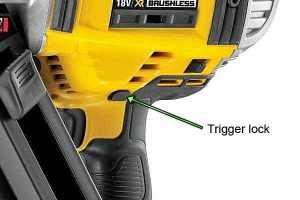
The trigger lock-off button is an important safety feature that, when pushed to the right, prevents the nail gun from firing. You should always lock the trigger when you’re not using the nailer for any length of time or are making adjustments, loading nails or clearing jams. Just push the button back over to the left to make the tool fully operational again.
Ergonomic Design
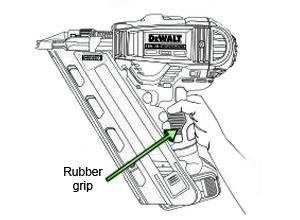
Although DeWalt’s framing nailer is obviously larger than some of its other power tools, in the hand it feels well balanced and reassuringly similar to a drill, with an ergonomically designed rubber grip for comfort.
Weighing 4.1kg including battery, the DCN692 nail gun is lighter and more compact than earlier models. Moreover, it’s small enough to fit between a 400mm centre stud, making it ideal for use on partition walls.
Dry Fire Lock Out
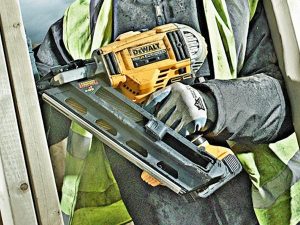
When the magazine is nearly empty and there are only around 7 to 9 nails left, a dry fire lock will be activated to prevent the tool from expelling any more. This safety mechanism aims to protect the nail gun from damage caused by empty firing.
Simply lock the trigger, disconnect the battery and load up a fresh pack of collated nails to carry on. The magazine will hold up to 55 nails.
Versatile Magazine Angle
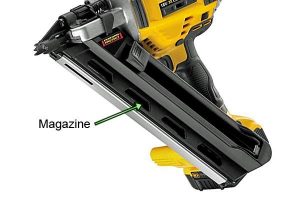
The magazine angle is a versatile 30-34 degrees, making it suitable for most types and makes of collated framing nails.
These include clipped head and off-centre round head nails packaged in paper or plastic strips, as well as wire weld packs.
Non-Mar Contact Tip
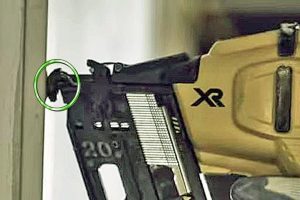
Supplied as standard with DeWalt nailers, a rubber non-mar tip is an extremely useful accessory.
You can can fit it on to the nose of the nail gun to protect wooden surfaces from accidental dents, scrapes and scratches while you are working. Some users prefer to remove the non-mar tip for delicate tasks that require maximum precision.
What to look for in a DeWalt Second Fix Nailer?
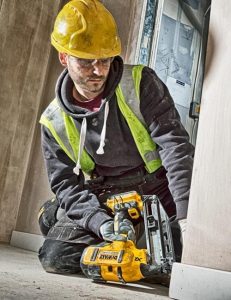
The DeWalt DCN660 second fix, or finish nail gun offers most of the same high quality features as the DCN692 framing nailer – an efficient brushless motor, bump and sequential modes, depth control, trigger lock, ergonomic grip and a non-mar tip. However, there are a few differences:
Weighing only 2.65kg with battery, it is lighter and more compact than a framing nailer.
It takes smaller nails – 1.6mm (16 gauge) diameter and 32mm – 63mm long.
The magazine is angled at a shallower 20° and will hold 110 nails as opposed to 55 for the framing nailer Dealing with jams is completely tool-free thanks to a jam-clearing latch on top of the nosepiece.
The motor is single speed, making the tool simple to operate.
You can use 2.0Ah or 5.0Ah batteries – it will fire about 800 nails with a 2.0Ah battery and 2,200 nails with a 5.0Ah battery.
There is no dry fire lock-out, so you need to keep an eye on the magazine.
Two LED worklights offer excellent illumination and also serve as warning indicators for low battery and jammed nails.
The DeWalt second fix, or finish nailer’s compact size combined with a rapid action and powerful motor make it a highly versatile tool, perfect for many kinds of work including carpentry, kitchen fitting, woodwork and installing interior trim such as skirting boards and coving. Thanks to the protective rubber tip it won’t leave marks behind, and plaster is much less likely to crack as you won’t have to make repeated hammer blows.
Whether you’re a professional or a DIY enthusiast looking to get just one nail gun for a variety of light projects around the home, a finish nailer would make a sound choice.
Nail Gun Safety

A nailer is a powerful machine, so treat it with respect and always follow the manufacturer’s instructions for its use and care.
A few safety tips:
Never point the nail gun at yourself or anybody else.
Never squeeze the trigger unless the tip of the nailer is pointing towards the workpiece.
Never pull the trigger or press the trip mechanism while loading the tool.
To avoid accidental firing, always detach the power supply when the nailer is not in use, as well as when making any adjustments, clearing a jam, cleaning the tool or moving to another work area.






